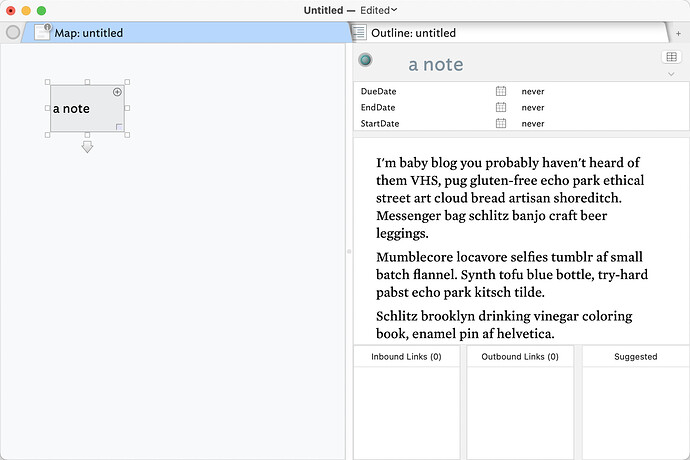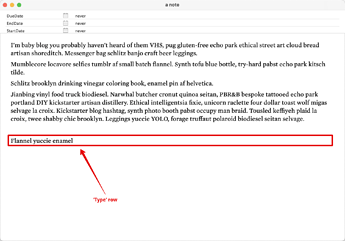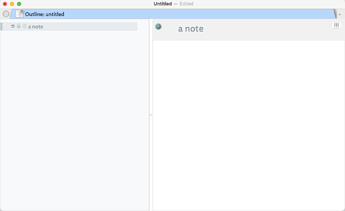I think it’s probably technically tricky to do, but this is one interface affordance that sometimes pulls me back to Scrivener. The other is the ability to write with page border and get accurate printing But, of course, part of the brilliance of tinderbox is how well it plays with other tools. Command Tab is pretty easy.
My favorite line and scene, ever! Thanks for the grin, Mark.
Woah! I want to be a writer. (More out of choice, as I ran my manufacturing business to the ground and have run out of any capital to invest in more business, writing is the only thing that compounds and doesn’t need any capital).
My problem is I am not doing much great writing except churning out a blog post every month (ghostwriting on Political Economy).
My wish is to be more prolific. Tinderbox is a great tool so far.
I could not agree more. For me, the key is to develop your workflow strategy with Tinderbox and the related tools.
I think I noted when we moved from Tbx5 to 6 that it had become more ‘writerly’ - that’s how it felt to me at the time.
I organise my (increasingly conceptually complex) main project with Tbx and am writing longer notes than I used to, but what stops me writing more is - literally - the bottom of the screen. I am now so used to the luxury of typewriter mode in Scrivener (and Ulysses on the iPad) that I seem not to write so well without it.
Is typewriter mode possible for Tinderbox?
Oh, I so second that, @DrDog! Typewriter mode (which Scrivener is not the only app to have) would be so welcome in Tinderbox. @eastgate, are you listening?
(BTW: I have been trying for some time to lobby the makers of BBEdit to add typewriter mode, so far without effect. If others here, who also use BBEdit, would join the effort, we might jointly be successful! 
To be sure I understand you, in “typewriter mode”, whenever a keystroke causes the insertion point to move to a new line, the window scrolls so the baseline of this new line scrolls to the former baseline?
“Typewriter scrolling—one of my favorite features—which keeps the line you’re working on at a fixed position on the screen” (Typewriter Scrolling – Scrivener Classes)
Yes - a fixed line which the page scrolls past. Scrivener allows: top quarter of screen, top third of screen, centre etc
Ulysses is the most flexible with the scroll line fixed wherever you want it to be
Diarly implementation is a bit duff: simple lines of padding somewhere near the bottom third of the screen.
Thanks, Eric
Would this make mosat sens if done in a stand-alone text window. Most files I sed at present look like this:
… a default doc window size with a note with some Displayed Attributes and the links pane open .
But in a stand-alone window:
… which offers better scope for seeing some text whilst still using a typewriter mode. A side note, a text note can expand to fill the screen, but not go full screen.
I’m not sure I understand as I’m not sure how it could work. The raison d’être of type-writer mode (as I see it) is to make the process of writing smoother by keeping the line you are writing in one place on the screen - generally well above the central line.
I write in the text view with the outline on the left - having to open a stand-alone window seems to be an unnecessary extra step which defeats the purpose.
But as I say, I could well not be reading your suggestion correctly.
Thanks, Eric
No problem. In a normal default view, there is no requirement to display the Displayed Attributes table (even if set for that note) or the links pane. Plus the view/text pane splatter can be pulled left to give more writing space like so:
But, if Scrivener is the UI which which you’re most familiar, that has a left column to the window where the binder works as a proxy outline view.
I’d simply assumed that the view pane is a distraction, the removal of which is the point of the typewriter mode. Unsurprisingly, what is a distraction, in terms of app UI, is subjective.
But, apologies, I wan’t trying to stir the pot, but only to clarify the underlying assumptions at play. 
Hi Mark,
Pardon me for butting in, but I think you are at cross purposes. It is the VERTICAL alignment that is at issue here, not horizontal.
The point of typewriter mode is that it keeps the text in the same place with regard to top and bottom of the screen.
Cheers.
Thanks for the thoughts, Mark. I would argue that typewriter mode should best be settable on a per document basis, i.e. as a tickable box in Cmd-8, “Text” tab.
If one writes lengthy texts per note (as I just had to do for a long report with upwards of 50 notes containing overall some 25000 words), it is tedious to always bump up against the bottom of the screen. Of course one can avoid that by entering 25 carriage returns at the end of the text (that one deletes again after ending the editing), but that’s just as tedious. Much better to simply tick a box in the document settings if you need to edit long documents (which may not be so often). And that should be available in all windows, not only text windows.
Would that be complicated to add, @eastgate?
Thanks Mark - in my normal default view I do not display the Attributes table or the links pane, and I have the text pane as large as I need. It might not seem like it because of the way I write about it, but the software UI with which I am most familiar is Tinderbox! On a weekly basis, when not in a text archive, I spend at least 2/3 of my software time in Tinderbox and 1/3 elsewhere.
Thanks again, Eric
Yes, we are on the same page. I was simply pointing out that the default space in which the writing would occur might be a sub-par start! People often mentally visualise features eliding the inconvenient parts. ‘Typewriter’ input strikes me as working better in a larger space. Not whole screen as a ‘screen’ size can vary massively from 13" to 40+" so one solution does not fit all.
Ah, OK … I was a bit confused by the reference to Scrivener and the binder. It seemed you were more concerned with the horizontal space. And of course one of the most obvious features of a typewriter is that the carriage moves sideways as you type! Which does make me wonder about how the phrase “typewriter mode” came into use …
Hmmm. I’m not sure I share that impression myself. If you are used to typewriter mode I think you could get used to looking at the middle of a “page” as a habit, even if it is a small area. My first degree was in art history, and I became very aware of how the eye is led around by all sorts of visual cues, etc. I wouldn’t be surprised to learn that there is a sort of visual equivalent to “muscle memory”. Personally, I like my text panes to be fairly narrow but tall (laptops can be sadly restrictive). I find wide text arrangements rather hard to follow. So I suppose my narrow and tall layout makes typewriter scrolling more valuable.
Now, what about the possibility of putting the links pane to the side of the text pane, instead of the bottom!! ![]()
![]() (Don’t take that too seriously!)
(Don’t take that too seriously!)
Cheers,
Martin.
Unfortunately, Cmd+8 is already mapped to open the Document Settings dialog - the the Edit menu
If looking for ‘free’ shortcuts, my Reverse Look-up Map can help. There, we see that Cmd+9 is not currently in use. So that might help.
Like you, I generally break notes into roughly <5k word notes—25,000 words/50— if there is no urgent need to make them longer. Noting that Tinderbox was originally designed around notes. On a fast Mac any delay swapping focus in/out of longer notes is likely not noticeable.
All windows? Actually, tThere are only two places you can (effectively) edit $Text. One is the text pane (part of) a document window. the other is in a standalone text window. So in that sense of “all text editing window”, Yes. ![]()
Mark, misunderstanding - I meant adding it to the Document Settings Dialogue. Just another tickable box in there - I thought users would most likely want to set this on a per document basis; I know I would!
Yes. It can be done, but it’s fairly complex.
One obvious question here is the following scenario.
- You’re typing on line 15 of 30, which is currently located at the center of the text pane.
- You press a key to insert the character “M”, which moves the current word to the start of the next line.
We now must move the scroll position so the baseline of the new line is at the same place as the baseline of the previous line. Is the scrolling instantaneous, or animated? If animated, how much time does it take, and do we ease-in, ease-out, or both?
Also, in an empty window, do we still begin with the baseline at the vertical midpoint?


